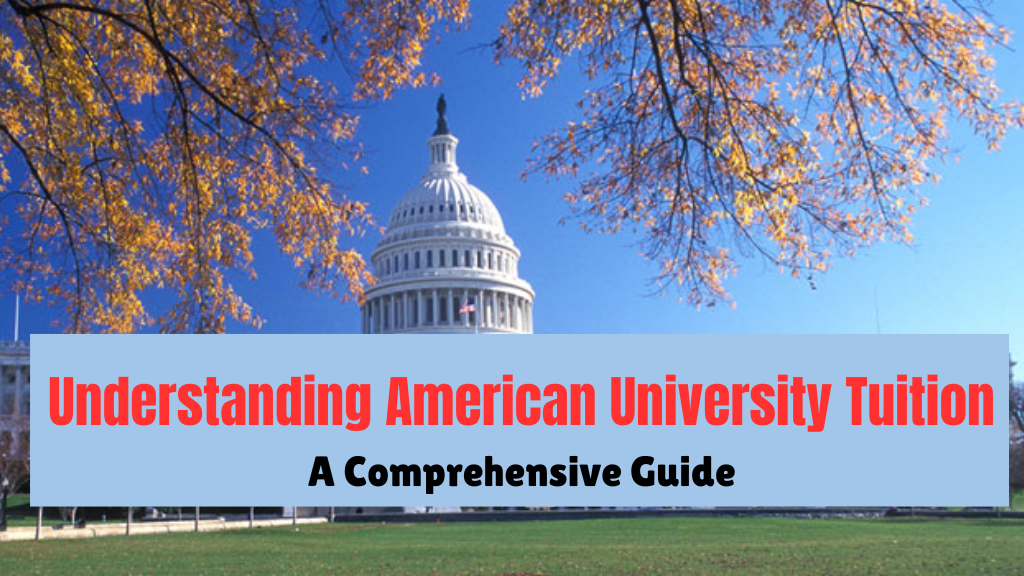Understanding American University Tuition American universities are globally renowned for their quality education, diverse programs, and extensive research opportunities. However, one of the most significant considerations for prospective students and their families is the cost of tuition. In this detailed guide, we will explore the various aspects of American university tuition, including its structure, factors influencing costs, financial aid options, and tips for managing educational expenses.
1. Overview of American University Tuition
1.1 The Structure of Tuition Fees
Tuition fees in American universities are generally categorized into several components:
- Base Tuition: The primary cost associated with attending classes and accessing university resources.
- Non-Resident Fees: Additional charges for out-of-state or international students.
- Program-Specific Fees: Costs that vary based on the specific academic program or major.
- Miscellaneous Fees: Includes charges for services such as health, technology, and student activities.
1.2 Variation Across Institutions
Tuition fees vary significantly across different types of institutions:
- Public Universities: Typically have lower tuition fees for in-state residents due to state funding.
- Private Universities: Often have higher tuition rates as they rely more on private funding and endowments.
- Community Colleges: Offer more affordable tuition rates, often serving as a stepping stone to four-year institutions.
2. Factors Influencing Tuition Costs
2.1 Geographic Location
The cost of living in the university’s location can impact tuition fees. For instance, universities in urban areas or high-cost states like California and New York tend to have higher tuition rates compared to those in rural or lower-cost regions.
2.2 Institutional Prestige
Highly ranked and prestigious universities often charge higher American University Tuition due to their reputation, faculty, research opportunities, and alumni networks.
2.3 Program of Study
Certain programs, especially those in fields like engineering, business, and health sciences, may have higher tuition fees due to the resources and specialized faculty required.
2.4 Enrollment Status
Full-time students typically pay a flat rate, while part-time students pay per credit hour, which can result in different overall costs.
2.5 Duration of Study
The length of the degree program affects the total tuition cost. American University Tuition Accelerated programs or dual degrees may have different fee structures.
3. Financial Aid and Scholarships
3.1 Types of Financial Aid
- Grants: Need-based financial aid that does not need to be repaid.
- Scholarships: Merit-based awards that do not need to be repaid.
- Loans: Borrowed funds that must be repaid with interest.
- Work-Study Programs: Part-time employment opportunities for students to earn money while studying.
3.2 Federal Financial Aid
The U.S. Department of Education offers various federal financial aid programs, including the Pell Grant, Federal Supplemental Educational Opportunity Grant (FSEOG),American University Tuition and federal student loans.
3.3 State and Institutional Aid
Many states and universities offer their own financial aid programs, which can include grants, scholarships, and tuition waivers.
3.4 Private Scholarships
Numerous private organizations, foundations, and companies offer scholarships based on academic achievement, community service, and other criteria.
3.5 Applying for Financial Aid
To apply for most financial aid, students must complete the Free Application for Federal Student Aid (FAFSA). This form collects information about the student’s and their family’s financial situation to determine eligibility for aid.
4. Strategies for Managing Tuition Costs
4.1 Budgeting and Planning
- Create a Budget: Outline all potential costs, including tuition, books, housing, and living expenses.
- Plan Ahead: Start saving early and explore various savings plans, such as 529 College Savings Plans.
- Consider Community College: Start at a community college and then transfer to a four-year institution to save on tuition.
4.2 Exploring Financial Aid Options
- Research Scholarships: Look for scholarships that match your qualifications and apply to as many as possible.
- Utilize Grants: Apply for federal and state grants to reduce the overall cost.
- Consider Work-Study Programs: Earn money through campus employment while gaining valuable work experience.
4.3 Reducing Costs
- Live Off-Campus: Sometimes off-campus housing can be more affordable than on-campus options.
- Use Open Educational Resources: Save on textbook costs by using free or low-cost educational resources.
- Take Advantage of Tax Credits: Explore tax credits like the American Opportunity Tax Credit (AOTC) to offset educational expenses.
5. Impact of Tuition on Students and Families
5.1 Financial Burden
High tuition costs can place a significant financial burden on students and their families, leading to increased student debt and financial stress.
5.2 Educational Choices
Tuition costs can influence students’ choices regarding which university to attend, what major to pursue, and whether to attend full-time or part-time.
5.3 Long-Term Effects
The financial strain of paying for tuition can have long-term effects, including delayed homeownership, lower retirement savings, and career choices influenced by the need to repay student loans.
6. Trends and Future Outlook
6.1 Rising Tuition Costs
Tuition fees have been rising steadily over the past few decades, outpacing inflation and wage growth. This trend is expected to continue, driven by factors such as reduced state funding American University Tuition for public universities and increasing operational costs.
6.2 Efforts to Control Costs
Some universities are implementing measures to control tuition costs, such as tuition freezes, discounts, and increased financial aid offerings.
6.3 Policy Proposals
Various policy proposals aim to address the issue of rising tuition, including free community college programs, increased federal funding for higher education, and student loan forgiveness initiatives.
Navigating the landscape of American university tuition can be complex and daunting. However, by understanding the various factors that influence tuition costs, exploring financial aid options, and implementing strategies to manage expenses, students and their families Tuition fees have been rising steadily over the past few decades, outpacing inflation and wage growth. This trend is expected to continue, driven by factors such as reduced state funding American University Tuitionfor public universities and increasing operational costs.
can make informed decisions and effectively plan for the financial aspects of higher education. While the cost of tuition is a significant consideration, American University Tuition the long-term benefits of obtaining a quality education can outweigh the financial challenges, providing a solid foundation for future success.
7. In-Depth Analysis of Tuition Costs at Different Types of Institutions
7.1 Public Universities
Public universities are state-funded institutions that offer a variety of undergraduate and graduate programs. These institutions typically have two tiers of tuition: in-state and out-of-state.
- In-State Tuition: Significantly lower due to state subsidies.
- Out-of-State Tuition: Higher, reflecting the lack of state funding.
For example, the University of California system offers substantial discounts for California residents compared to out-of-state students. In-state students pay around $13,000 per year, whereas out-of-state students pay approximately $42,000 per year.
7.2 Private Universities
Private universities do not receive state funding and rely on tuition, endowments, and donations. As a result, tuition fees are generally higher, but these institutions often have substantial financial aid budgets American University Tuition.
- Tuition Range: Varies widely, with some elite institutions charging over $50,000 per year.
- Financial Aid: Many private universities offer generous need-based and merit-based aid packages.
For instance, Harvard University has a “need-blind” admission policy, meaning they admit students without considering their financial situation and provide financial aid to meet 100% of demonstrated need.
7.3 Community Colleges
Community colleges offer two-year associate degrees and are an affordable option for many students.
- Tuition Rates: Typically much lower than four-year institutions, averaging around $3,500 per year.
- Transfer Opportunities: Many students start at community colleges and then transfer to four-year universities to complete their degrees.
For example, Santa Monica College in California offers a robust transfer program to universities within the University of California system.
8. Hidden Costs Beyond Tuition
8.1 Textbooks and Supplies
Textbooks can be a significant additional expense, with some students spending over $1,000 per year. Many universities are transitioning to digital and open educational resources to help mitigate these costs.
8.2 Room and Board
Living expenses, including housing and meals, can sometimes exceed the cost of tuition, especially in high-cost areas. On-campus housing is often more expensive but provides convenience and community, American University Tuition while off-campus housing can be cheaper but requires careful budgeting.
8.3 Transportation
Whether commuting or living on campus, transportation costs can add up. Public transportation, car expenses, and parking fees should all be considered when budgeting for college.
8.4 Miscellaneous Fees
These can include health insurance, technology fees, and activity fees. It’s essential to review all potential charges to understand the total cost of attendance.
9. Case Studies: Tuition Costs at Top American Universities

9.1 Harvard University
- Tuition (2023-2024): $54,002
- Room and Board: $18,389
- Additional Fees: $4,902
- Total Cost: $77,293
- Financial Aid: Harvard’s financial aid program aims to make education affordable for all admitted students, with about 55% receiving need-based aid.
9.2 University of California, Berkeley
- In-State Tuition (2023-2024): $14,226
- Out-of-State Tuition: $44,008
- Room and Board: $17,220
- Additional Fees: $5,814
- Total Cost (In-State): $37,260
- Total Cost (Out-of-State): $67,042
- Financial Aid: UC Berkeley offers need-based and merit-based scholarships, as well as work-study opportunities.
9.3 Community College Example: Santa Monica College
- Tuition (In-State): $1,146
- Tuition (Out-of-State): $8,190
- Room and Board: Varies by living situation
- Additional Fees: $200
- Total Cost (In-State): Approximately $1,346 plus living expenses
- Total Cost (Out-of-State): Approximately $8,390 plus living expenses
- Financial Aid: Santa Monica College offers federal and state grants, scholarships, and work-study programs.
10. Long-Term Financial Planning for College
10.1 Savings Plans
- 529 College Savings Plans: Tax-advantaged savings plans designed to encourage saving for future education costs.
- Coverdell Education Savings Accounts (ESAs): Another tax-advantaged savings option, though with lower contribution limits compared to 529 plans.
10.2 Early Financial Education
Teaching children about money management and the importance of saving early can help prepare them for the financial responsibilities of college.
10.3 Parental Involvement
Parents can assist by contributing to savings plans, researching financial aid options, and guiding their children through the application process.
10.4 Student Responsibilities
Students should also take an active role in managing their finances by applying for scholarships, seeking part-time employment, and budgeting their expenses carefully.
Understanding the intricacies of American university tuition is crucial for students and families aiming to make informed decisions about higher education. While the costs can be daunting, American University Tuition a combination of strategic financial planning, exploring various financial aid options, and choosing the right institution can make higher education more accessible. By taking a proactive approach, students can navigate the financial landscape of American universities and American University Tuition invest in a valuable educational experience that paves the way for future success.


1 thought on “Understanding American University Tuition: A Comprehensive Guide”